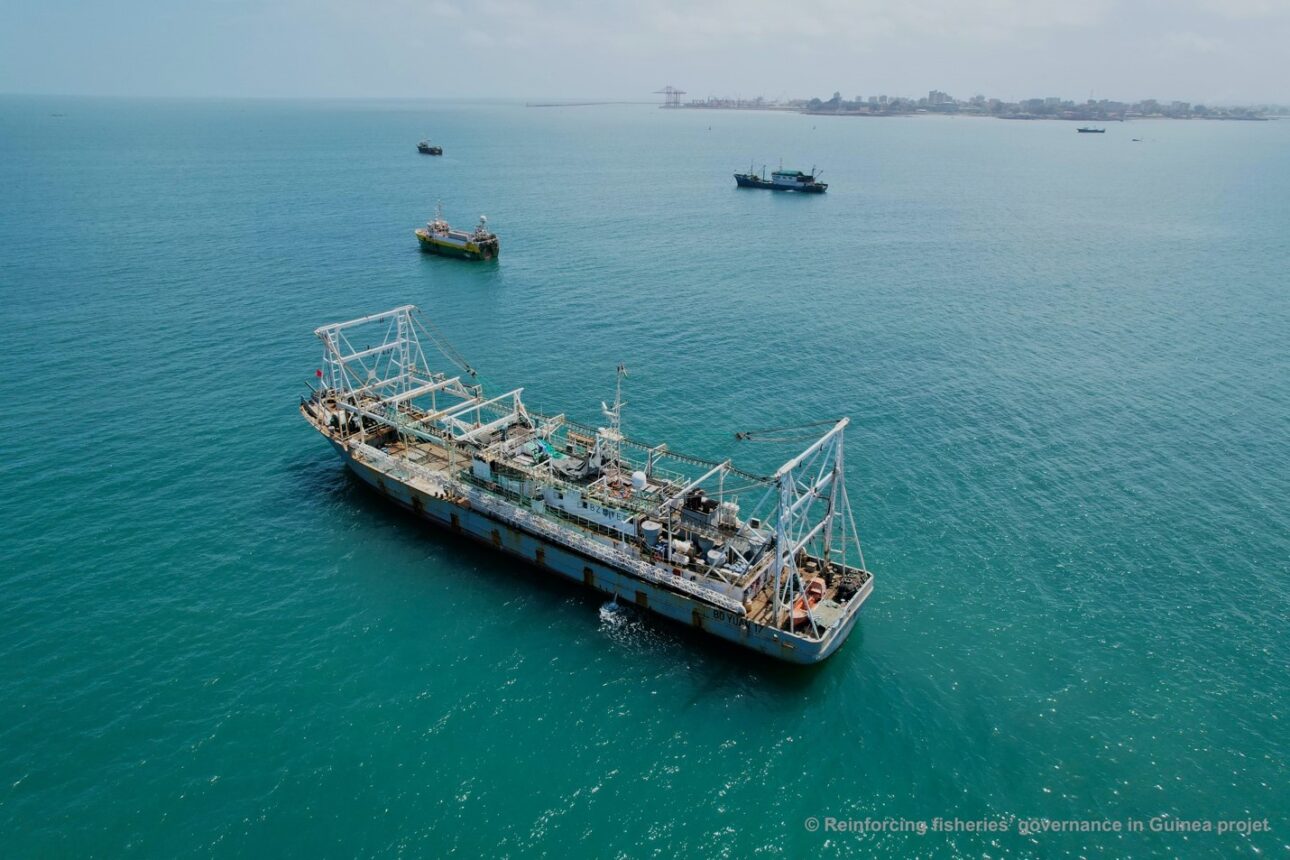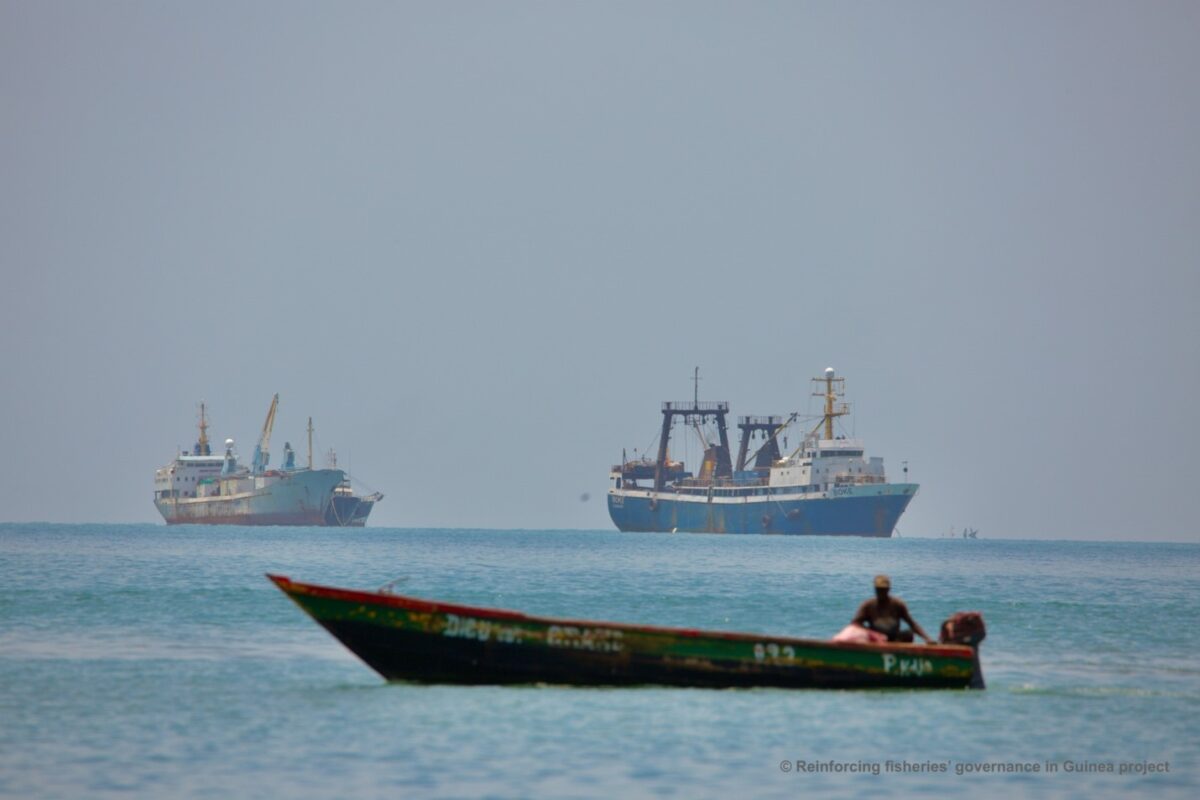Multi-stakeholder partnership project
Since 2021, GRID-Arendal, in partnership with Trygg Mat Tracking (TMT), the Regional Partnership for the Conservation of the Coastal and Marine Zone (PRCM), and the Ministry of Fisheries of Guinea (Conakry), has been leading the project Reinforcing Fisheries Governance in Guinea, with generous financial support from OCEANS 5. This multi-stakeholder initiative aims to establish robust sector-specific legislation and support the implementation of effective monitoring and enforcement methods. By engaging local actors in fisheries management and providing training in the use of innovative techniques, the project seeks to improve the management and transparency of Guinea’s fisheries through reforming the sector’s policy framework, enhancing monitoring and reporting of illegal activities, and promoting sustainable fishing practices.
An active engagement of the Guinean government and local stakeholders in policy reform processes constitutes a key component of the project. This includes establishing intra-governmental working groups to strengthen the legal framework, improve monitoring, and increase transparency in the fisheries sector. The project covers two key aspects. The first one aims to enhance inter-agency and multi-stakeholder collaboration leading to the strengthening of policies’ enforcement. The second aspect deals with the use of innovative technology (like Unmanned Aerial Vehicle – UAV and satellite imagery) to overcome surveillance limitations and support existing systems in combating Illegal, Unreported, and Unregulated (IUU) fishing activities.
Improving inter-administration collaboration: a critical overarching approach to building local capacity to fight illegal fishing and increase fisheries transparency
Effective fisheries governance requires a diverse range of stakeholders to coordinate efforts in a harmonious way. Our project, in collaboration with TMT and PRCM, delivered a comprehensive training to local actors responsible for the Monitoring, Control and Surveillance (MCS) of fisheries, enhancing transparency in the fisheries sector by including legal, technical, and procedural aspects.

Workshop in Conakry, Guinea with the agent in charge of the fisheries MCS
We initiated inter-agency to foster clear processes, flow, and accessibility to fisheries-related information. Early in this project, it became clear that critical aspects of the fisheries sector transparency such as the licensing process, or the surveillance of fishing activities, needed multi-stockholders’ involvement. Nevertheless, the framework was not yet set for an efficient and clear collaborative work. The information on potential illegal activities by some vessels was not always accessible to decision-makers, and agencies responsible for enforcement were not always fed with real-time information to carry out their duties. Under TMT’s supervision, efforts were made to improve the information flow among Guinea’s fisheries MCS entities, increasing transparency and surveillance efficiency. This, among other things, led to establishing a secure communication platform, inter-agency and multi-stakeholder working groups, and a commonly recognized responsibilities framework to significantly improve fisheries governance.
Bringing new opportunities in fisheries surveillance through innovative technology
Coastal countries, especially in low-income states like Guinea, face challenges in controlling their maritime Exclusive Economic Zone due to limited MCS capacities. These limitations facilitate opaque and uncontrolled fisheries activities, reducing potential gains in transparency that can be reaped through important policy sector reform, or other meaningful initiatives. Innovative technology such as satellite imagery, vessel tracking systems and drones, offers a cost-effective solution for fisheries surveillance, providing real-time data and high-resolution imagery, and is safer and more affordable than traditional methods. Despite some limitations, ongoing improvements are enhancing its capabilities and making it a real solution to support increased transparency in fisheries.

Drone shot taken during a patrol demonstration involving UAVs technologies in Guinea in May 2023
The “Reinforcing Fisheries Governance in Guinea” project explored the possible integration of drone technologies into Guinea’s fisheries MCS system together with other remote sensing systems (like satellite imagery and tracking systems). Following a comprehensive assessment, a strategy was developed, and a “Drone Working Group” was formed to take this initiative further. Workshops and demonstrations validated the feasibility of using drones for routine and reactive missions. Two key demonstration sessions engaged local stakeholders and provided them with a hands-on training. Building on the inter-agency and multi-stakeholders working group created by the project, the enlarged collaboration with key institutions in Guinea, i.e. the National Environmental Surveillance and Observation Center (CNSOE), helped identify factors for selecting appropriate drones, including range, weather resistance, payload, and cost. Operational integration was planned with the Maritime Prefecture, the National Center for Fisheries Surveillance and Protection (CNSP), and the Gendarmerie maritime as end-users, and a comprehensive data management strategy was developed. These efforts successfully laid the groundwork for enhancing Guinea’s fisheries MCS system with the use of innovative technologies, adding a tool to improve transparency in the fisheries sector.
Conclusions
While inter-agency and multi-stakeholder collaboration is globally recognized to be crucial for MCS success, it is often overshadowed by more tangible actions like training, policy reforms, or technical capacity development. Projects like ours remind us that strengthening inter-agency cooperation not only yields direct results, but it also amplifies the impact of all project activities. As a natural extension of these initiatives, integrating drone technology into fisheries surveillance is greatly enhancing Guinea’s capacity for monitoring and managing its resources. This approach offers a cost-effective, efficient, and safer solution, complementing existing efforts to address illegal fishing and resource management challenges. Embracing drone technology not only fills surveillance gaps, but it also maximizes the benefits of policy reforms, capacity building, and improved transparency, thus strengthening Guinea’s fisheries surveillance and its ability to combat IUU fishing activities.
GRID-Arendal and partners, through this project and similar initiatives like the “Blue Bijagos” project in Guinea-Bissau and the FishGuard partnership, offer comprehensive solutions to reinforce fisheries governance, reduce IUU fishing activities, and enhance transparency. These solutions encompass a full chain of concepts aimed at improving the management of fisheries in low-income countries, providing support in policy and legal framework development, capacity building and technological innovation, integrating earth observation remote sensing monitoring technology and UAVs (Drones) into traditional resources and stakeholders’ central cooperation. By addressing these key areas, the partnership aims to provide a holistic approach to sustainable fisheries management and effective governance that can be replicated in other countries in the area.
Please visit our website and get in touch. We are excited to be developing a combination of these approaches, providing an inclusive solution to fisheries governance needs and challenges. Our main priority in 2024 is to expand the scope of these projects with a larger consortium of partners, leveraging our respective skills to ensure successful replication and broader impact of our efforts.




